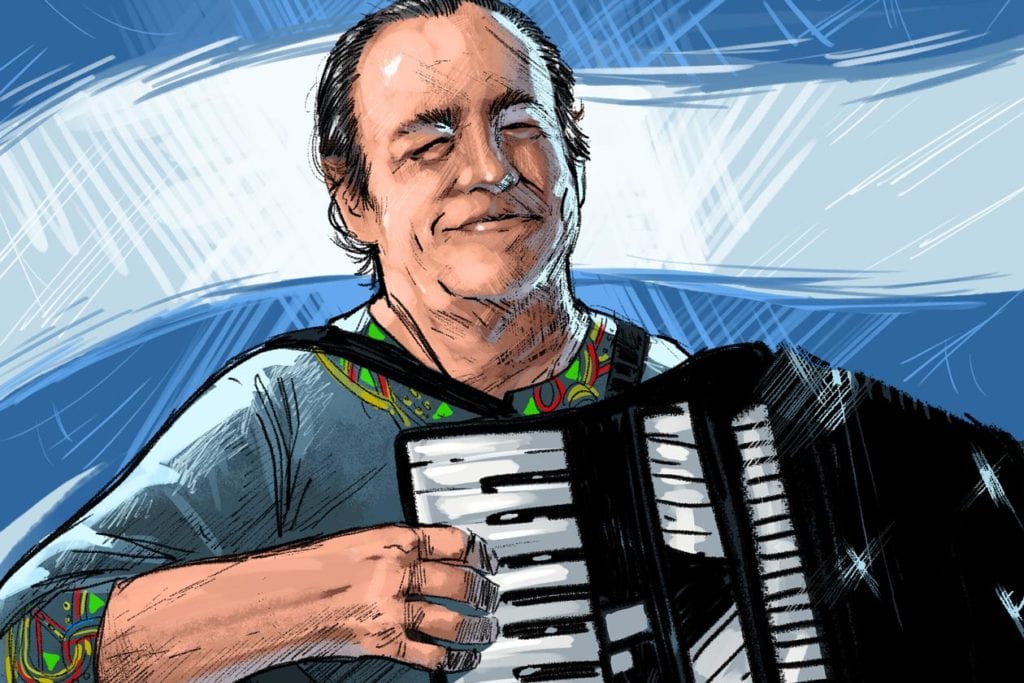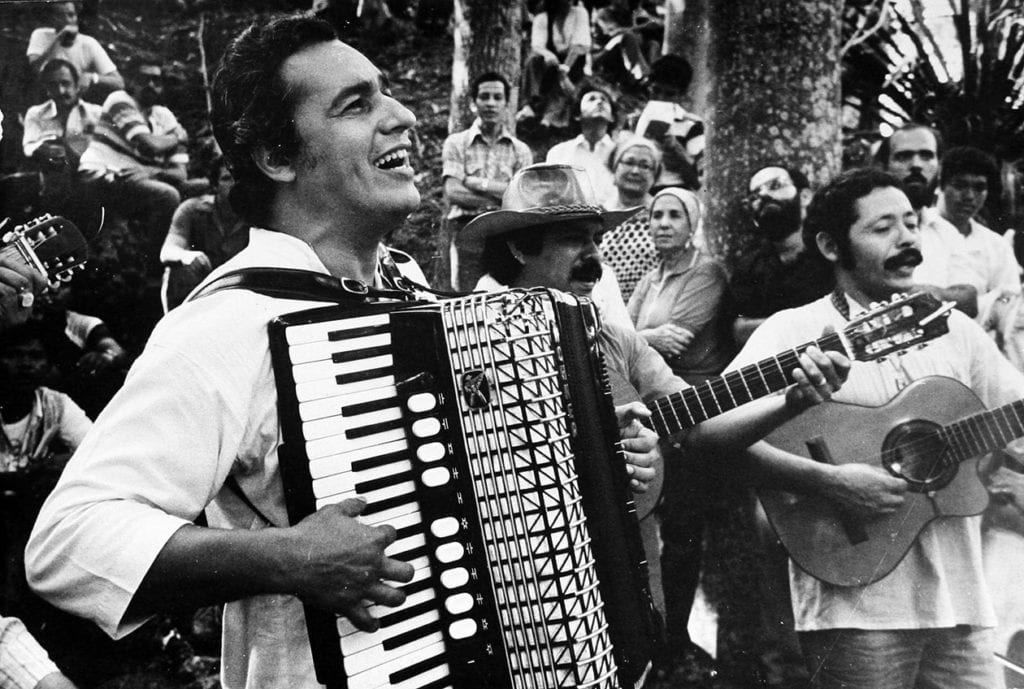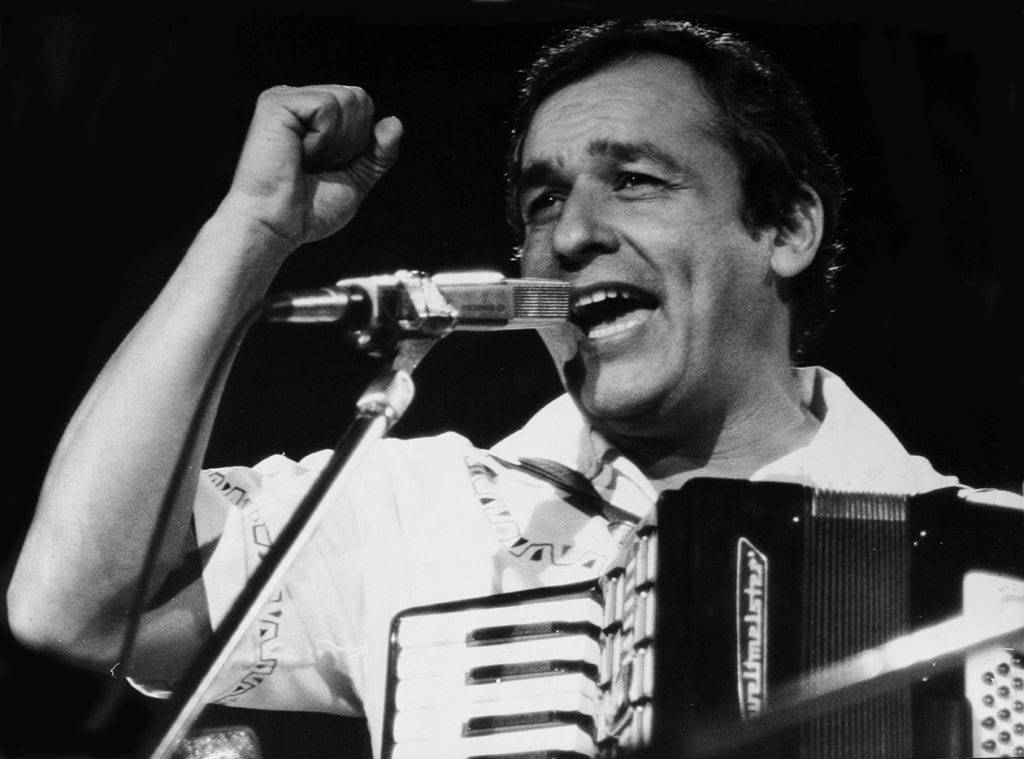“Carlos Mejia is the Soul of Nicaragua”

“To me, the Sandinista Popular Revolution can’t be explained without the music of Carlos Mejia and the poetry of Ernesto Cardenal,” assures author Sergio Ramirez.
By Carlos Salinas (Confidencial)
HAVANA TIMES – If writer Sergio Ramirez had to choose just one song from Carlos Mejia Godoy’s repertoire, he says it would be “Aquel almendro de ‘onde la Tere” [“That almond tree by Tere’s place”] because it’s a song that evokes our nostalgia for a lost childhood.” To Ramirez, Mejia Godoy’s music is very special, not only because of its quality, but for what it has represented in his life, given that the Nicaraguan singer and composer provided “the soundtrack” to the Sandinista Revolution. The writer was an active part of this process that turned Nicaragua into a world legend.
Ramirez affirms that the revolution couldn’t be understood without Mejia Godoy’s music, “Carlos wasn’t only the troubadour, but also the constant musical accompaniment to the revolution,” states the author of “Adios Muchachos” [“Goodbye, lads”]. During this interview, Ramirez laments the new exile forced on Carlos Mejia Godoy, walks us through a review of the singer-songwriter’s career, and recognizes what his work has meant for Nicaragua. “He’s the mirror that reflects Nicaragua,” he declares.
What place does Carlos Mejia’s work hold in the scope of Nicaragua’s musical roots?
Carlos has always had a very particular ear for capturing Nicaraguan speech and the Nicaraguan identity in general, and for transforming them into music, setting the speech to rhythm. Of course, speech has a rhythm and a melody of its own, and where it has the greatest melody is in the north of Nicaragua. There’s an accent there like from the Golden Ages. You have to take into consideration that in the north there are many remote valleys where antiquated forms of speech have also been preserved, along with some out-of-the-mainstream ideas.
From childhood, Carlos knew how to listen to the humor in this form of speech, and to transform it into music. That was his first great virtue. And he also does this roguishly, with originality, humor and a lot of romanticism. I would call him the direct and most authentic heir of Camilo Zapata, who had this same kind of ear and sense of naughtiness, but Carlos is more than that: he gives another dimension to the speech and the music. Certain compositions of his have become cultural icons, and others like “Ay, Nicaragua, Nicaraguita” have become alternative national anthems.
How much does the Sandinista popular revolution owe to Carlos Mejia Godoy?
Everything! Carlos gave the Revolution a soundtrack. To me, the Sandinista Popular Revolution can’t be explained without the music of Carlos and the poetry of Ernesto Cardenal. Carlos was not only the troubadour, but also the constant musical accompaniment of the Revolution. Carlos eventually converted his entire body of music into revolutionary music at the service of a revolution. For doing this, he paid the price of not becoming the international star he would have been if he’d stayed in Spain. He dedicated himself here in Nicaragua not only to composing music for the revolution, but also to composing songs of combat, putting into music a manual for assembling or disassembling weapons. That’s amazing to me.
Would you say that Carlos Mejia Godoy helped create a collective social sentiment in support of the Revolution?
Carlos once wrote a song about Christmas, about the poor children at Christmas, and I recall that a friend told me: “Carlos writes that song, and my wife puts it on during the Christmas dinner, and they all end up going out and giving away the food.” He sensitized everyone to the fact that the Revolution wasn’t just a change in the political figurehead or of a dictatorship, but a change in attitudes towards the poor, the humblest people.
What place does Carlos Mejia Godoy hold in Latin American culture, beside monumental singer-songwriter figures such as Violeta Parra?
One summer, the most popular song in Spain was “Son tus perjumenes, mujer” [roughly – “Woman, it’s your perfumes”]. The success of that song opened the doors of the CBS record company to Carlos, and the doors to all those places where people go to spend their summers. He could have pursued that road, but he renounced that frivolous success for a commitment, a truly profound commitment.
When the Soccer World Cup was being held in Argentina, they offered him thousands of dollars to use the song “Quincho Barrilete,” but changing the words, since this was the time of the military dictatorship there. He said no. Not only because of the military, but because he didn’t want a song of his to become commercialized. Not everybody does things like that.
Carlos is a man who renounced getting rich, because he believed in a cause. His music is very different from that of Pablo Milanes, Silvio Rodriguez or Joan Manuel Serrat. Maybe Carlos’ music has more local color, because he didn’t get into exploring a merely romantic genre. It never occurred to Carlos to write a romantic bolero, for instance, something that would have nothing to do with Nicaraguan traditions, that wasn’t involved with the struggle. It doesn’t surprise me that at the moment when these massacres began to occur, that he should take this same conscience and begin to write music in favor of the victims.
Do you feel that one of the chief legacies of Carlos Mejia has been that he internationalized the Nicaraguan culture through his music?
That’s important to me, but more important is that his music reflects our heart and soul. What has interested him most – more than international fame – is being the soul of Nicaragua, the mirror that reflects Nicaragua. When I’m at the airport, I always see people buying Carlos Mejia’s CDs. He’s like a photo of the volcano Momotombo, something that embodies Nicaragua to those outside the country. Someone in the solitude of their apartment one night will put on that music of Carlos Mejia Godoy’s and will cry there alone, with a few shots of rum inside them, because that’s Nicaragua.
What place does “La Misa Campesina” “[The Peasant Mass”] hold in the vast musical works of Carlos Mejia Godoy?
It’s the most complete musical body of work that’s ever been produced in Nicaragua. Carlos is a great organizer, a great orchestrator of Nicaraguan music. Chopin’s sonatas were nothing more than popular airs from the Polish countryside that he transformed. What Carlos does in “La Misa Campesina” is to put together music from the indigenous Miskito tribes, music from the rodeo rings, all of it’s there, reorganized. It’s music from the time when Liberation Theology was new, and the Christ that Carlos reflects there represented that whole tendency. That’s a true work of art.
“La Misa Campesina” provoked outrage from the most orthodox sector of the Church.
Yes. In the Medellin Congress (1968), under Pope Paul VI, the Church chose the preferential option for the poor. Later, however, when John Paul II came on the throne and the Puebla Congress was held (1979), they put the brakes on the decisions made in the Medellin congress. They tried to put an end to that tendency of Liberation Theology, and its preferential option for the poor. “La Misa Campesina” was written in that context, and it speaks of Christ the worker, and Christ the peasant, the Christ who sweats in the street and the Christ that cries out for the liberation of the poor.
Many saw in that a classist concept of Christ, and said “No, Christ belongs to the rich and the poor”, but that’s a theological postulate. The song says that Christ belongs to everyone, but preferentially he’s the God of the poor. If “La Misa Campesina” had been only about that, it would have died already, but it’s a work of art and it’s still with us.
In Nicaragua, it was prohibited by a bishop from Leon, but the Vatican itself never prohibited it. The Episcopal Conference never really rectified their position, but at the funeral held for Fernando Cardenal in the Central American University, Cardinal Brenes officiated at the mass and they played “La Misa Campesina.” I remember that I wrote in my blog that “La Misa Campesina” was back, that it had been played in front of the Cardinal and that I hoped it would now stay once and for all and that the absurd prohibition would be lifted. It depends on each individual priest; I don’t believe that Cardinal Brenes ever said that it was forbidden. Right now, in the current circumstances in Nicaragua, is when the Mass should be played.
If you had to chose your one favorite song by Carlos Mejia, what song would it be and why?
That’s a difficult question to answer. I’m going to go with “Aquel almendro de onde la Tere” [“That almond tree by Tere’s place”], because it’s a song that evokes our nostalgia for a lost childhood. It’s a work of art in itself; everybody remembers their own early childhood, the little girl you were in love with. Everyone went through a place like that. To me, its lyrics are perfect, it’s poetry, and Carlos was very right to set it to a Habanera rhythm, because that gives it a very nostalgic feel.
Gioconda Belli: “His music made us love Nicaragua”
Carlos Mejia Godoy was the singing bird that proclaimed the Revolution, and his music was a fundamental element in sensitizing people about the injustices, and about the path the FSLN wanted to pursue later on. I’ve always said that Carlos Mejia Godoy created the soundtrack so the Sandinista Revolution could exist in beauty and humanism.

When we sang the music of Carlos Mejia Godoy, that so many of us learned by heart, it made us love Nicaragua, its people, its stories. It was decisive in forming the conviction that we were a people capable of overthrowing a dictatorship. “La Guitarra Armada” [“The armed guitar”] was also a way – “with a little music” as he himself would say – to teach the people how to assemble and disassemble the arms that they captured from the National Guard. An arms manual made into a song – What an extraordinary thing!
The music of Carlos Mejia Godoy during the ten years of Revolution and in the harshest years of scarcity and the Contra war, revived the spirit of the struggle, cheered us up with his light-hearted style and his representation of our idiosyncrasies. What Carlos gave us was invaluable. Every song gave back to us the idea of a Nicaragua that was worth struggling and sacrificing for. The paradox, of course, is that those same songs that motivated the struggle against a dictatorship have once again become relevant, as we go back to living those terrible times, at the hands of someone who was once a Sandinista.
In Central America, Carlos’ music is Nicaragua. That’s how it was in Spain as well. We had the good luck of having our most authentic and masterful singer there with us expressing the struggle of the Nicaraguan people. That also encouraged other countries in Central America and even in Europe to act in solidarity with us. No one could hear that music and not love the Nicaraguan people who inspired the singer.
My favorite songs are “Cuando yo la vide” [“When I saw her”] which is a love song from the rural interior, innocent and roguish at the same time, and “No pasaran” [They shall not pass”], perhaps because the words are from a poem of mine that Carlos set to music. To listen to an entire plaza full of people singing that song was to understand the marriage between poetry and music; to witness something intimate, like a poem, converted into the voice of a multitude. It’s one of the strongest emotions that I’ve ever experienced.
The government of Daniel Ortega has reached the summit of contempt for its own history and values when someone such as Carlos Mejia Godoy has to leave the country because he feels threatened. They appropriated his music, and now they take away his peace of mind.
Ernesto Cardenal: “Troubadour of the Revolution”
I used to see Carlos Fonseca, founder of the Sandinista Front, fairly often. He would complain to me that in Nicaragua there wasn’t any revolutionary music, what we called testimonial music, as there was in Cuba with the nueva trova [new folksong] movement, and also in Chile and many other parts of Latin America. Sometime later, at a cultural presentation at the National University I heard Carlos Mejia Godoy singing, among other songs, the one that uses the letters of the FSLN. That same day, or very soon afterwards, I told Fonseca that the music he wished for had already made an appearance. Fonseca was a man of few words and made no comment. Maybe he already knew the same thing, and it wasn’t news to him. From then on, we began to hear an entire body of Carlos Mejia Godoy’s revolutionary songs, and around that time Carlos Mejia Godoy and myself became great friends.
One day, Carlos Mejia came to Solentiname with his musical group to get inspiration from a popular Mass. There were many of these in Latin America, and in Nicaragua we also had ours, which was pretty good but not sensational. With the inspiration that Carlos received in Solentiname, he created the Mass called Misa Campsina. This was a mass that was not only sung in a popular style, but was also genuinely rural in its roots. It soon became popular in Nicaragua and afterwards all over the world.
Fernando, my brother who was a Jesuit, and I assisted Carlos theologically, although we didn’t intervene at all in the creation of the mass. We only explained a few times the meaning of the words of the traditional mass that in our own modern times weren’t well understood. Like for example, the Kyrie Eleison [“Lord, have pity,” a transliteration from the Greek used in the Roman Catholic Mass]; to our ears, it sounds like blasphemy to present a God who we ask for pity, as if we were the merciful ones. But we explained that the word “pity” meant compassion for the oppressed, while the “pitiless” was the oppressor, and that the actual meaning of the word was “solidarity”. The solidarity or compassion of Che Guevara for the poor for example, and that’s how the expression “Senor ten piedad” [Lord, have pity] appeared in Carlos Mejia’s mass.
Carlos Mejia’s Mass wasn’t easily accepted from the beginning, because it spoke of a “God of the poor, who sweats in the street, with a weathered face”. All that is absolutely orthodox, although it may seem heretical or blasphemous. I myself was shocked by some of those expressions but I was encouraged to accept them by the example of our friend Carlos Mantica, who was fairly conservative but who supported them unreservedly. That’s why it shouldn’t seem strange that some bishops didn’t approve. Even now it’s theoretically prohibited, but the public knows better, and this mass is extremely popular in Nicaragua and around the world.
——–
Favorite songs of Niu readers

We asked the readers of Niu what were their favorite Carlos Mejia Godoy songs. We received more than 120 responses on Twitter, and we prepared this list of songs that you can listen to and share on Spotify. Here are some of our readers’ opinions:
@OpositorNica
I like “La viejecita de Mozambique” [“The old woman from Mozambique,”] because the one who dies with a rifle in their hands, defending the freedom of their nation, is as important as the one who dies in exile, dreaming of returning.
@ester_flores
“Quincho Barrilete”. At this time, it’s the children who the Ortega-Murillo regime have tortured the most, and this song honors the children who struggle and dream. A huge hug from me for Carlos Mejia and my admiration. I’m from Costa Rica.
@El_miusculo
Complicated, but I’d go with “Viviras Monmbo” [“Long live Monimbo”] because it’s a song I love to sing, it energizes me. Also, even though it was written a long time ago, it has once again gained relevance in expressing the fierceness at the heart of Nicaragua.
@hjmunzy
“Juancito tiradora” [Little Juan and his slingshot] because it recalls those kids who’ve fought against the Ortega regime with nothing but a slingshot in their hand.
@asatho11
“El Zenzontle pregunta por Arlen” [The Mockingbird asks about Arlen”]. In addition to being a gift of poetry, it’s a beautiful demonstration of love for Arlen Siu and all the Nicaraguan women who are determined and fighters.
@AbogadaDdhh
“Las mujeres del Cua” [“The women of Cua”] because it tells of the tortures and suffering of women who grew up in times of war. The song gives a new dignity to the history of those in the countryside.





